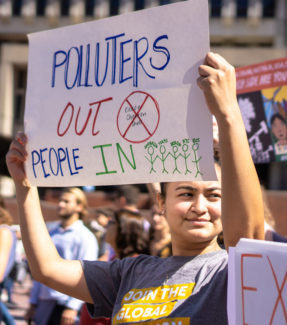By Nadra Nittle for Civil Eats.
Buying locally really can make a difference. The Los Angeles Unified School District (LAUSD) found this out in 2012 after adopting a good food purchasing program (GFPP)—a policy that gives institutions a framework for buying local, sustainable, and humanely sourced food. After the school district implemented the program, its produce and bread distributor, Gold Star Foods, changed its business practices to meet the GFPP guidelines and keep LAUSD as a client. This created a ripple effect: Gold Star added 65 new jobs and began sourcing its bread from Shepherd’s Grain network, a sustainable agriculture enterprise; Shepherd’s Grain, in turn, expanded its network of more than 40 wheat farms across the West Coast in order to provide the 160,000 bushels needed each year to serve the school district.
When it adopted the GFPP seven years ago, LAUSD kicked off a burgeoning movement across the country that has since seen a city, county, and several other school districts institute these programs. School districts in Cincinnati, San Francisco, Oakland, and Washington, D.C., have implemented GFPP policies, as has the Cook County Board of Commissioners, which represents the Chicagoland area.
When the Boston City Council unanimously passed a GFPP ordinance in March, it became the first New England city to do so, and could jumpstart even more momentum for GFPP implementation. A coalition of more than 20 groups worked to bring Boston’s GFPP ordinance to fruition, but they found a particular champion in Councilor At-Large Michelle Wu, who introduced the legislation to the city council.
“My hope is that the growing GFPP will bring the issue of food justice to a wider audience and build momentum for systemic change,” Wu told Civil Eats by email. “So many of us take food for granted as a basic need that has to be met without realizing that the food supply chain is rife with abuses—of workers, animals, environment and health—and we have the power to change that. The return to local, sustainable, fair, humane, and healthy is one of the most fundamental shifts to build a better future.”
Serving 11.1 million meals annually with an $18 million food budget, Boston Public Schools (BPS) is the city’s biggest food purchaser, and if history is a guide, the GFPP will lead to big changes in BPS’s school lunch menus. Two years after LAUSD’s GFPP went into effect, the percentage of locally purchased fruit and vegetables served had risen from 9 percent to 75 percent. The district also reduced its yearly meat spending by 15 percent, saving more than 19 million gallons of water, according to PolicyLink, which advances public policy that promotes equity in society. Additionally, the GFPP has resulted in $12 million in its supply chain being redirected to purchase local produce, according to the Center for Good Food Purchasing.
GFPP advocates applaud the changes they’ve seen as a result of LAUSD’s policy, but are pushing for entire cities to implement these policies, as Boston has. The Center for Good Food Purchasing currently has campaigns in Minneapolis-St. Paul, Buffalo, and New York City.
“I would love for this to be replicated all across New England and all up and down the East Coast,” said Taylor Billings, the press secretary for Corporate Accountability, a Boston-based organization that launches campaigns to hold companies responsible for upholding issues including human rights, public health, and environmental stewardship. “The fact that Boston’s GFPP is citywide is powerful. Any public institution that purchases food needs to meet these standards. It needs to go beyond public schools.”
What stands out about Boston’s policy is that it not only requires the city to procure sustainably grown food, consider animal welfare and the local economy, but also to focus on racial equity in the food chain during the purchasing process—something not as emphasized by previous GFPP adoptees. Advocates hope Boston could influence other cities, particularly New York and others in New England, to implement similar policies.
“Boston’s policy is a strong model for other cities not just because of the clear racial equity measures, but also because of the strong language around transparency,” said Suzanne Adely, a regional organizer for the Food Chain Workers Alliance. “There are other cities and counties that have passed the GFPP, and we’ve already been able to see a strong impact in terms of reduction of carbon footprint and use of the policy to negotiate fair contracts for food distribution workers. What we wanted to achieve as far as Boston is to look at the strongest language in those other policies and put that information into Boston’s ordinance.”
Boston’s Transparency Provision
The Center for Good Food Purchasing will manage Boston’s adoption and implementation of the GFPP ordinance—it’s designed to employ a multifaceted approach that takes into account the local economy, environmental sustainability, the food workforce, animal welfare, and overall nutrition to promote more equity in the food system. Under the GFPP, for example, the city will prioritize buying food grown in Massachusetts. City institutions will have “broad discretion” to buy food directly from local farmers and food suppliers, which will potentially create more food processing, manufacturing, and distribution jobs.
In accordance with GFPP guidelines, Boston will give preference to food producers that avoid using synthetic pesticides or fertilizers, antibiotics, and genetic engineering in their goods. Food producers will also be encouraged to conserve soil and water, protect wildlife habitat, treat animals humanely, and reduce energy consumption and greenhouse gas emissions.
Paula Daniels, cofounder of the Center for Good Food Purchasing, said that it was important for the ordinance to address the role that food procurement plays in both the economic and environmental sectors.
“We want to go deeper and look at what kinds of policy and partnerships would help spur investment in supply chain systems to do the right thing,” she said.
Daniels and other GFPP advocates say that the Boston ordinance’s call for transparency gives it an edge over earlier policies, such as LAUSD’s 2012 GFPP, which did not include guidelines specifically related to measuring transparency. In Boston, suppliers will have to share data to give city departments an idea of how well they’re following GFPP standards. Additionally, suppliers will have to meet food procurement benchmarks, verify their food sources, and commit to public review of their practices. City departments will provide annual progress reports to the City Council about how well suppliers are meeting policy standards.
Putting the GFPP standards into place and demonstrating how their practices line up with these guidelines will be a roughly two-year process for the city’s food suppliers.
Calling Attention to Workers’ Rights
Supporters say the Boston GFPP’s focus on racial equity in the food worker chain makes it more progressive than its predecessors. Under the ordinance, the city of Boston will advocate for socio-economically disadvantaged communities by giving preference to food vendors with a history of paying workers living wages, hiring employees from marginalized communities, or basing their businesses there—as long as they also use environmentally friendly practices. Farmers and food workers of color as well as minority-owned businesses all stand to benefit from the equitable hiring guidelines. The ordinance also calls for the city to purchase food from businesses that respect the rights of workers by allowing them to organize into unions and providing safe working conditions for them.
“It was important to our group to include this provision emphasizing racial equity and closing the wealth gap, because that’s a glaring area of need in Boston,” Wu said. “The work aligns with other initiatives that we have been pushing on the Boston City Council, including equity in opportunity for city contracting overall for businesses owned by people of color and women. At a time when so much is at stake in government and society, we want to get every bit of value of spending taxpayer dollars, and this push for equity needed to be part of our food justice plans.”
Boston is a racially diverse city, with a population that’s 44.9 percent white, 25.3 percent African American, 19.4 Latinx, and 9.5 percent Asian American. The city, however, has been described as one of the nation’s most segregated, and has a large racial wealth gap, as Wu noted. Boston’s Black households only have a median net worth of $8, compared to $247,500 for white households.
What’s more, Boston has a troublesome record on civil rights: The city was famously court-ordered to desegregate its schools after a federal judge ruled in 1974 that it had created separate school systems for white and Black children. In response to the court decision, white mobs opposed to racially integrating schools swarmed and attacked buses transporting Black children to schools in the white South Boston neighborhood. “It was like a war zone,” a Black student later recalled of the violence, virtually indistinguishable from the vicious opposition to integration that occurred in the Jim Crow South.
In light of the legacy of historic racism, Adely said that that it’s especially important to use GFPP policies to advocate for racial equity in the workforce.
“Our success depends on who’s at the table,” she said. “It depends on opportunities, resources for different communities, especially Black communities, women, indigenous communities, small farmers, and family farmers. Part of the GFPP’s goal is to give these groups opportunities to benefit from this market.”
Boston’s Children Have the Most to Gain
Since Boston Public Schools is the city’s biggest food purchaser, the GFPP will affect students the most. The new ordinance emphasizes purchasing healthy foods, including large servings of fruits, veggies, and whole grains, eliminating foods with artificial additives, and a reduction in foods containing salt, added sugars, fats, and oils. This complements BPS’s efforts to improve students’ access to healthful food through its My Way Café program launched last year. The program earmarked funding to build 30 new school kitchens in the district to allow more students to eat healthful meals cooked on-site.
“In joining the GFPP movement, Boston will see healthier school lunches for our students, while strengthening the environment and our local economy by investing in food producers here,” Wu said.
Alexa Kaczmarski, senior organizer for Corporate Accountability, said that Boston’s policy stands out by striving to meet children’s nutrition needs while also ensuring their food isn’t sourced in harmful ways.
“When we talk about food and food policy, we often only think about the end result—how nutritious is the food we’re giving our kids?” she said. “But the food we give to students needs to come from a system that’s not harming animals, workers, or our bodies. This policy is so transformative because it impacts all of those concerns at every step—serving nutritious food that’s been grown sustainably and harvested by workers who are treated with dignity as much as possible.”
Adely is excited about the impact the GFPPs in various school districts will have on students and workers alike. She credits Wu’s advocacy with influencing Boston to establish a citywide policy. So far, lawmakers in others cities haven’t supported the ordinances in the impassioned way that Wu has, according to Adely. The councilwoman said that she was motivated to support the ordinance because food is essential to life.
Food access is a basic part of each person’s daily survival, and yet the policies we set up as a society often frustrate healthy individual choices,” Wu said. “If we can shift the paradigm toward food justice, we will strengthen our communities in several fundamental ways: personal and public health, environmental sustainability, good jobs, and fewer barriers to food access.”




